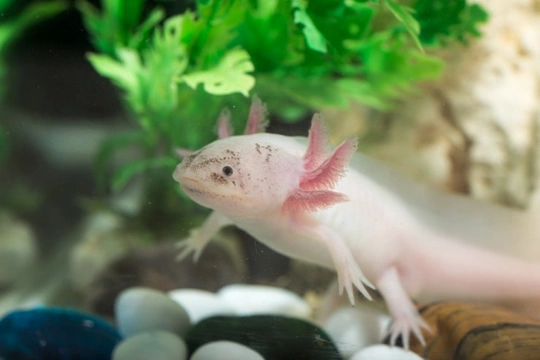
Keeping an axolotl as a pet
The axolotl is a type of aquatic salamander that looks somewhat like a cross between a fish and a lizard! While axolotl are definitely unusual and have a very distinctive appearance- being somewhat like a standard looking lizard, but with gills and an underwater habitat- they are actually relatively easy to keep as pets, with a little research and understanding of their nature and what is involved. Intrigued? Read on to find out more!
Why do axolotl make interesting pets?
As well as being very distinctive looking (most of your visitors will never have heard of axolotl at all, unless they happen to be reptile enthusiasts)! Axolotl have a range of other uniquely interesting characteristics that are appealing to many pet lovers. They have superior regenerative qualities, even in comparison to other lizards, such as those that can regenerate their tails and scales. Axolotl heal very easily if injured, and can re-grow limbs such as a leg if hurt or attacked by other animals. While they are not hugely energetic and active all of the time, they are not generally prone to hiding or lying still for long periods of time, and so are eminently watchable and fascinating to observe.
All about axolotl
Axolotls are neotenic, which means that they don’t generally undergo the distinct metamorphosis from larvae to adult that usually occurs with other types of salamanders. They become sexually mature (and so reach adulthood) and reproduce within the water, instead of maturing and moving onto land. To further add to the confusion, axolotl do sometimes metamorphose into terrestrial animals, although almost without exception this only happens in the wild, and very rarely. Axolotl are native to Mexico, where many different sub-species of the genus exist. The type of axolotl that is commonly available to buy as pets within the UK are of the Ambystoma Mexicana genus. Correctly cared for, they are hardy animals that can live for well over ten years under suitable conditions. Axolotl should not be handled if at all avoidable, as their skin and gills are very soft and malleable and can easily become damaged. Young axolotl can become cannibalistic to others, and so should not be housed together while young. Sometimes adult tank mates can also be aggressive, especially if the tank is overcrowded, so this should be carefully managed. Axolotl will eat other fish and organisms in the water, so they should not be kept with other aquatic pets! Axolotl can grow quite large when mature- around 25 cm is not uncommon, although even larger domestic axolotl are by no means unusual either!
What do I need to care for axolotl?
The basic kit required to care for axolotl is not too dissimilar to that required for fish, with a few minor changes. You will need a sturdy glass or acrylic tank of at least 45 litres capacity to keep a couple of axolotl happily, as well as a suitable secure lid for the tank as axolotl are no strangers to climbing. You should keep the water temperature between 16 to 18 degrees celsius ( around 60 to 64 degrees fahrenheit), higher temperatures can lead to stress and possible death.It is also important that your axolotl are not subjected to the glare of bright light. While a tank light can be incorporated within the lid so that you can watch what your axolotl are doing, ensure that it is not too bright or intense, and that it is turned off for sufficient periods of time during the hours of darkness. You will also need to provide a substrate for the base of the tank. It is usually advised that you should use sand as the substrate, or alternatively, don't use any substrate at all. Ensure that you don’t use gravel or small stones, as axolotl may ingest these inadvertently which could get caught in their digestive tracts. Some hiding places such as ornaments and plants are also recommended. Finally, as with all aquatic creatures, water quality and filtration are incredibly important. A water filter should be incorporated into your axolotl’s tank, and the tank should be cleaned out regularly with partial water changes performed as needed. If you use tap water in the tank, this should be treated first with appropriate supplements for the water quality in your area, much as is the case when keeping fish.
What do axolotl eat?
In the wild, axolotl eat a wide range of foodstuffs such as fish, crustaceans, worms and other reptiles. When kept in a tank, it’s important to note that regular fish food is not a suitable substitute for their natural diet, and you will have to pay a little more attention to your axolotl’s feeding routine than you would if keeping fish. Brine shrimp, tubifex worm, bloodworm and other suitable meals can all be bought easily from most pet stores in frozen packages, which can be stored at home and administered as appropriate. Axolotl can also eat pre-packaged dried fish food pellets such as those fed to farmed salmon and other carnivorous fish. Axolotl should be fed at least once a day, with any uneaten food cleared out of the tank promptly. Keeping your axolotl well fed is important, as hungry axolotl are exponentially more likely to see each other as a snack!
Where can you buy axolotl?
Axolotl are often available in larger pet shops that stock reptiles and fish, and from specialist retailers and breeders such as you can find online. Axolotl are relatively hardy and low maintenance animals to keep, but as with any potential pet, it is vital to research them thoroughly before considering a purchase, and ensure that you have both the time and financial resources available to be able to care for them for the duration of their lives.



